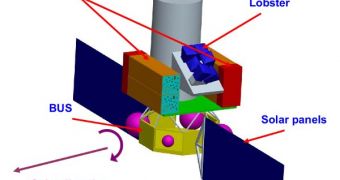German experts from the Max Planck Institute for Extraterrestrial Physics announce that one of their newest instruments, an X-ray detector that could be used for tracking down dark energy, will launch in 2012. The new mission will be a collaboration of the European Space Agency (ESA), the Russian Federal Space Agency (RosCosmos), the Max Planck Institute, and the University of Leicester Space Research Center, in the UK. The new spacecraft, which has yet to be designed, will need to have very sensitive instruments, capable of making out extremely weak X-ray signals coming from far away.
This wouldn't be too difficult of a task on its own, but the detectors need to function undisturbed by the vast amount of infrared, visible and ultraviolet light coming in from the hundreds of billions of stars in the surrounding Universe. According to the German team, their instrument, the eROSITA (extended ROentgen Survey with an Imaging Telescope Array) will need to function in the wavelength range of 1 to 50 nanometers. The trick is that the instrument needs to be made blind to several hundreds of nanometers in the adjacent range, so as to prevent “cross-contamination.” For the very first time ever, physicists at the Physikalisch-Technische Bundesanstalt (PTB) managed to characterize the needed spectral sensitivity of these instruments.
The accomplishment, coming from the same team that now controls four of the primary atomic clocks that contribute to setting up the UTC time, was made possible because the science group there has access to two advanced electron storage rings. This ensures that the facility can produce all required spectral ranges at optimum quality for research. Using the Metrology Light Source, the PTB group was capable of determining how to best shield the detectors from perturbing UV and visible light. At a separate facility, the team also analyzed the sensitivity of the detector in the soft X-ray range.
“The mission will conduct the first all-sky survey with an imaging telescope in the 2-12 keV band to discover the hidden population of several hundred thousand obscured supermassive black holes and the first all-sky imaging X-ray time variability survey. In addition to the all-sky surveys it is foreseen to observe dedicated sky regions with high sensitivity to detect ten thousands of clusters of galaxies and thereafter to do follow-up pointed observations of selected sources, in order to investigate the nature of Dark Matter and Dark Energy. The proposed orbit provides an order of magnitude lower particle background than those of Chandra and XMM-Newton, which will allow the detailed study of low-surface-brightness diffuse objects,” the mission statement reads.

 14 DAY TRIAL //
14 DAY TRIAL //